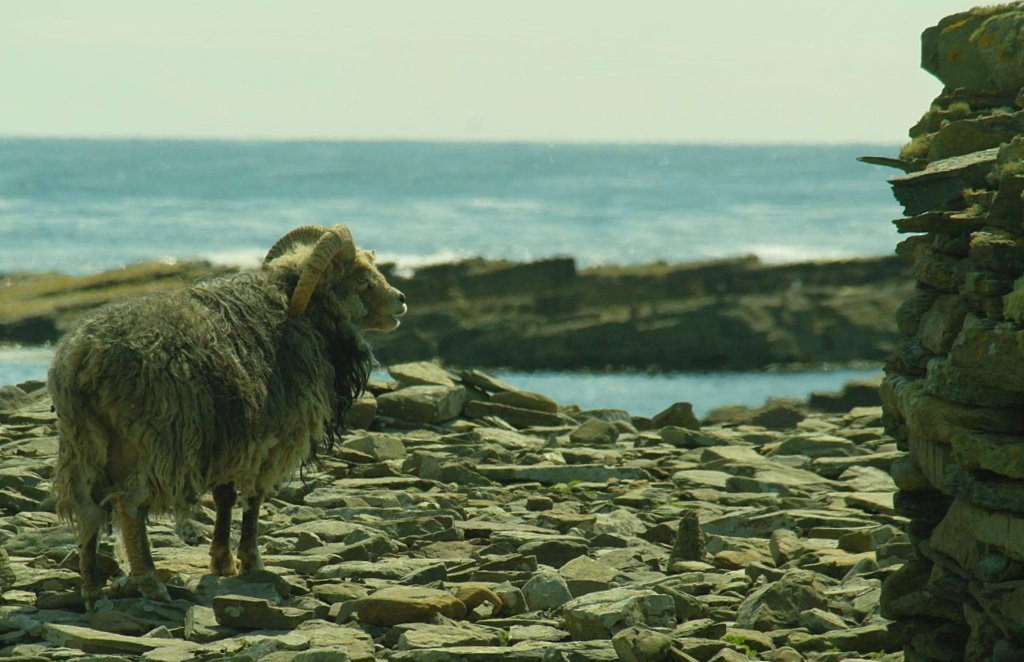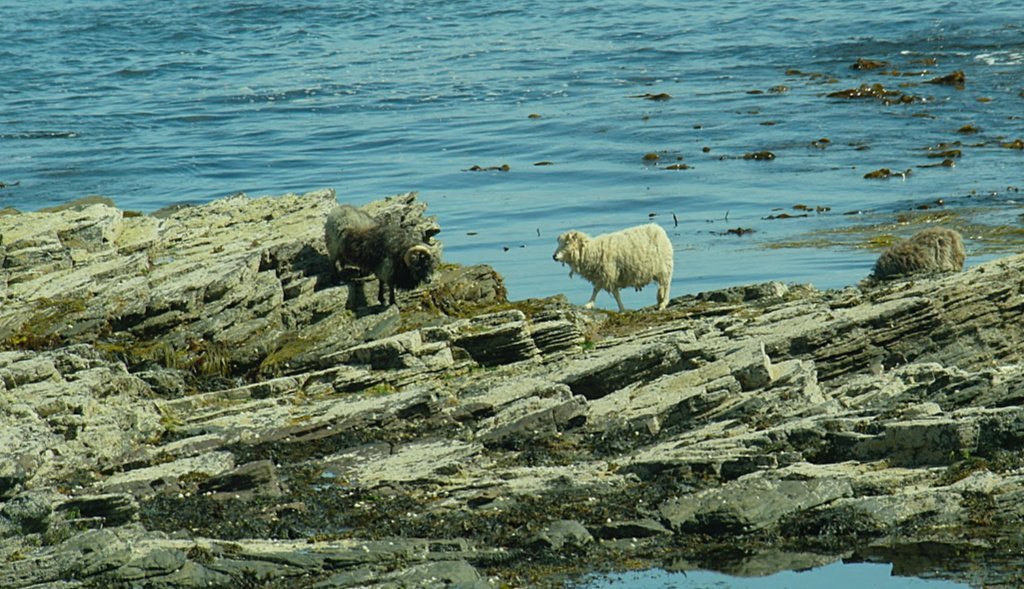North Ronaldsay sheep are a feature of this wacky island. A wall all around it keeps them on the shore, where they eat seaweed. See? Told you it was wacky. And the place is famed for the rare birds that turn up during migration. An excursion to this unusual Orkney island is worth considering.
This is a page about North Ronaldsay sheep. To be honest, when the plane touched down (and burst a tyre on the gravel, by the way – see the other North Ronaldsay page) I never thought I would be writing a page about, well, just sheep.
But if you spend time on this most northerly of the Orkney islands, then North Ronaldsay sheep kind of make their way into the frame, often quite literally when you are taking pictures.
These beasties have shaped the island’s past and still impact on the present.
The annual rounding up of the North Ronaldsay sheep also represents one of the few cooperative farming activities left in Scotland.
Furthermore, the North Ronaldsay sheep are a living link with our ancestors.
Well, maybe not your ancestors, but I fondly imagine my forebears were northern folk and might have kept a few sheep before they took to the sea.

North Ronaldsay Sheep In Orkney’s Prehistory
Bones of the same kind of sheep found today on North Ronaldsay have been found at Skara Brae, the famous Neolithic village discovered on mainland Orkney and which dates from c. 5000 years ago.
Make no mistake; these are unusual beasties that have rarity value.
Perhaps as a consequence, with only about 500 breeding female sheep registered in the UK, the breed has official ‘endangered’ status.
These short-tailed, horned sheep are characteristic of a type found in Scandinavia and were probably brought to the island by the first settlers.

How Many Sheep On North Ronaldsay?
There are, apparently, still 3,700 North Ronaldsay sheep on the actual island itself. Certainly, if you visit North Ronaldsay, that figure can be believed.
Every time you look over the wall (or keek oer the dyke, as I would prefer to say) you seem to be faced with a sheep, staring balefully back while grimly chewing on some seaweed it has chiselled off the barnacled rocks.

The North Ronaldsay Sheep Wall
Did I mention the wall? I really can’t make up my mind to call it a wall or a dyke – from Anglo Saxon ‘dic’ so it’s also cognate with ditch and dig.
Also I’ve just thought that not only do the Scots call a wall a dyke, so do geologists, in as far as a dyke is a wall-like protrusion and not a channel or, uhmm, ditch. (Know what? I wish I’d never started this….)
Anyway, as I trust (ahem) you have already read on the main North Ronaldsay page that, uniquely amongst the islands of Orkney and beyond, there is a large dry-stane dyke all around this island.
It is officially recognised as an important monument by Historic Environment Scotland (the government agency responsible for protecting our built heritage).
The wall keeps the sheep on the shore, except where it deviates inland and grudgingly allows them bits of links pasture. (Basically, I think they eat the golf course.)



Nae Trees On North Ronaldsay
The island always had an acute timber shortage (I mean nae trees).
Instead, it has historically relied on wrecks and driftwood – not ideal for house building purposes.
Instead, the vernacular architecture features flagstone roofs.
(All of this, of course, was before the B & Q store opened in Inverness.)
The 13 miles (21 km) of wall dates from the 1830s when it was built so that the pastures of the interior could be preserved for more valuable cattle.
The sheep were ‘exiled’ and ironically, because of this, the breed has remained true to its origins and not been cross-bred with ‘modern’ sheep.
I thought by now you’d seen enough sheep so here are some Arctic terns. On North Ronaldsay, they seem to co-exist with the sheep.
These terns dive-bomb the sheep when they come too close to their nests.
The Arctic tern has one of the longest migrations of any bird in the world – all the way to the Antarctic.
So when you’d flown all that way back to nest on North Ronaldsay, you’d not take kindly to getting your nest trodden on, no matter how rare the sheep that did it.
North Ronaldsay sheep are often described as primitive. Frankly, all the sheep I have ever encountered in Scotland both on field and hill seem to be some kind of non-discriminating woolly maggot.
So if the local sheep hereabouts are primitive, I do rather wonder what a sophisticated sheep must be like. But treat that as an aside.
I expect primitive in this sense must mean unchanged since Neolithic times.

Wool From North Ronaldsay
Anyway, the North Ronaldsay sheep are still important in the story of the most northerly of the islands of Orkney.
Today, thanks to the installation of a ‘mini-mill’- basically, scaled down spinning equipment for cottage industry – in the complex of lighthouse buildings, visitors can buy North Ronaldsay wool produced on the island.
It comes in a variety of natural shades – just about anything from white to black via fawns and browns.
If you can, it’s good to slip in the word ‘moorit’ when describing sheep that are brown-ish, as it’s a Scandinavian word linked to the colour of moorland but usually applied to a particular shade of sheep.
Though principally useful for their wool, a bit of a mystique has built up around North Ronaldsay mutton.
At least, that is the only explanation I can think of for the fact that it appears to retail at double the price of the most excellent local Orkney ‘ordinary’ lamb.
And a mainland Orkney farming lass we spoke to who keeps her own sheep (but not the North Ronaldsays) says she just doesn’t like the taste and that it is very gamey.
Perhaps it is the mutton equivalent of Laphroaig whisky – very distinctive, not quite like anything else in the range and eliciting a love it or hate it response.
But both wool and meat is still part of a tremendous brand that is gradually raising its profile.
North Ronaldsay Sheep and Global Warming
Wait, respect these primitive sheep though. In breaking (wind) news, it’s been announced that their seaweed diet is being further investigated.
In consequence of what they eat, they belch much less methane than the average sheep or cow.
That’s important because methane is a big contributor to global warming. Research is ongoing to find out if adding seaweed to animal feeds will reduce the gaseous emanations (what?) from the farming industry.
Anyway, I’m sure you’ve got the picture and know all you need to know about the North Ronaldsay sheep. What? You can’t get enough sheep. Well how about…the unmissable guide to Scottish sheep-spotting.
Or the ever popular hairy coos and where to find them in Scotland.